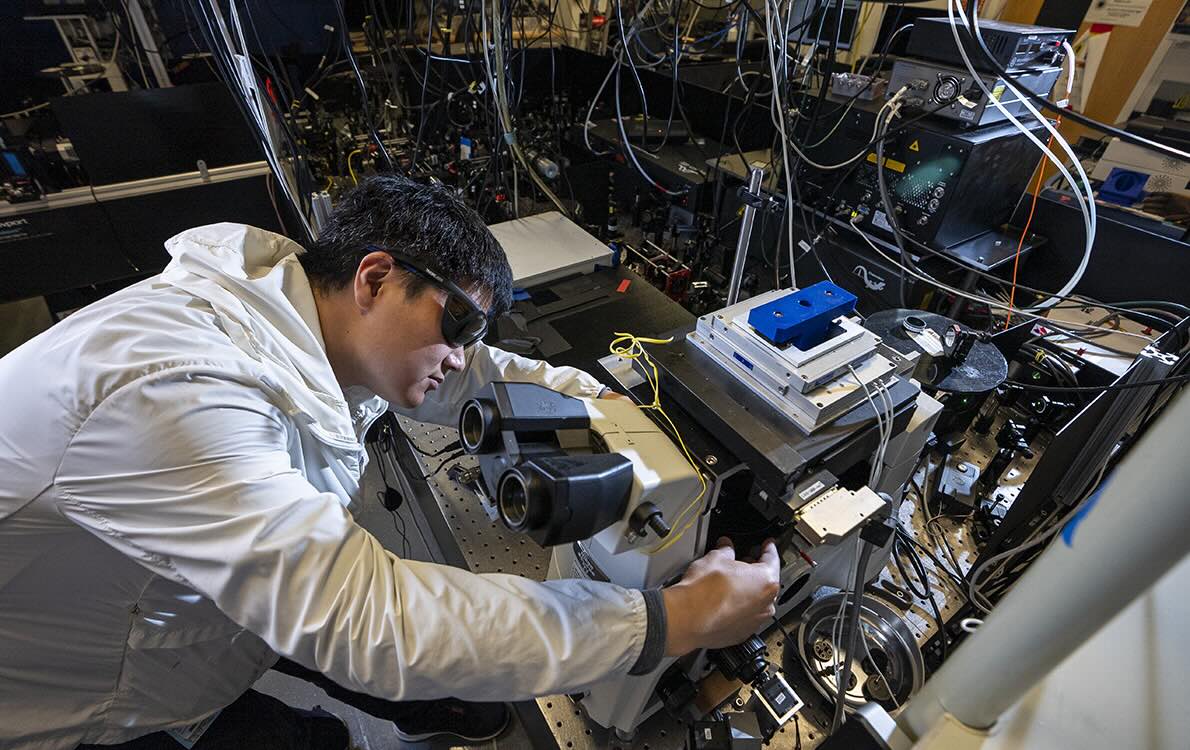Adapted from this Berkeley Lab press release

A research team of Foundry staff and users has developed a new optical computing material from photon avalanching nanoparticles.
The breakthrough – which the team published recently in the journal Nature Photonics – paves the way for fabricating optical memory and transistors on a nanometer size scale comparable to current microelectronics. This approach offers a path toward realizing smaller, faster components for next-generation computers by taking advantage of an optical phenomenon called “intrinsic optical bistability.”
“This is the first practical demonstration of intrinsic optical bistability in nanoscale materials,” said Emory Chan, a staff scientist in Berkeley Lab’s Molecular Foundry and co-lead author on the study. “The fact that we can reproducibly make these materials and understand their unintuitive properties is critical for making optical computers at scale a reality.”
The work is part of Berkeley Lab’s broader push to advance smaller, faster, and more energy-efficient microelectronics with new materials and techniques.
For decades, researchers have sought ways to make a computer that uses light instead of electricity. Materials with intrinsic optical bistability (IOB) – a property that allows a material to use light to switch between two different states, such as glowing brightly or not at all – could serve as components for optical computers. But in previous studies, optical bistability had almost exclusively been observed in bulk materials that were too big for a microchip and challenging to mass produce. And in the few earlier reports of nanoscale IOB, the process was not well understood and was assumed to occur by heating the nanoparticles, which is inefficient and difficult to control.
But now, Chan and the team’s recent study suggests that the new photon avalanching nanoparticles could overcome these challenges in realizing IOB at the nanoscale.
During experiments at the Molecular Foundry, a nanoscale science user facility at Berkeley Lab, the researchers fabricated 30-nanometer nanoparticles from a potassium-lead-halide material doped with neodymium, a rare-earth element commonly used in lasers.
When the nanoparticles were excited with light from an infrared laser, they exhibited a phenomenon known as “photon avalanching,” in which a small increase in laser power results in a giant, disproportionate increase in the light emitted by the nanoparticles. The team first discovered this “extreme nonlinearity” of photon avalanching nanoparticles in their pioneering 2021 paper, which demonstrated that doubling the laser power increased the intensity of the light emitted by 10,000-fold.
In their latest work, the team found that their new nanoparticles were over three times more nonlinear than those original avalanching nanoparticles, “the highest nonlinearities that anyone has ever observed in a material,” Chan said.
To the researchers’ surprise, further experiments in the current study showed that these nanoparticles not only exhibit photon avalanching properties when excited above a given laser power threshold, but they also continue to emit brightly even when the laser power is reduced below that threshold, and only turn off completely at very low laser powers. In other words, these tiny avalanching nanoparticles turned out to be the IOB that had long eluded nanoscientists.
Interested in Becoming a Foundry User?
Join our collaborative, multidisciplinary environment.
Learn more >
The large difference between these “on” and “off” threshold powers means that there are intermediate laser powers at which the nanoparticles can be either bright or dark, depending only on their history, Chan explained. This ability to switch optical properties without changing the material suggests that the nanoparticles may serve as nanoscale optical memory, particularly volatile random-access memory (RAM).
Seeking the origins of the groundbreaking bistability in these materials, the researchers then used computer models to reveal for the first time that IOB in their nanoparticles arises not from nanoparticle heating, but rather from the extreme nonlinearity of photon avalanching and from a unique structure that dampens vibrations in the particles.
In future studies, the researchers hope to study new applications for optically bistable nanomaterials and find new formulations for nanoparticles with greater environmental stability and optical bistability.
Read more in the full press release.

